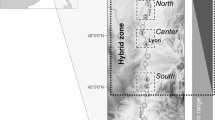Abstract
Most species of social insects have singly mated queens, although there are notable exceptions. Competing hypotheses have been proposed to explain the evolution of high levels of multiple mating, but this issue is far from resolved. Here we use microsatellites to investigate mating frequency in the army ant Eciton burchellii and show that queens mate with an exceptionally large number of males, eclipsing all but one other social insect species for which data are available. In addition we present evidence that suggests that mating is serial, continuing throughout the lifetime of the queen. This is the first demonstration of serial mating among social hymenoptera. We propose that high paternity within colonies is most likely to have evolved to increase genetic diversity and to counter high pathogen and parasite loads.

Similar content being viewed by others
References
Bourke AFG, Franks NR (1995) Social evolution in ants. Princeton University Press, Princeton, N.J.
Brown MJF, Schmid-Hempel P (2003) The evolution of female multiple mating in social hymenoptera. Evolution 57:2067–2081
Cole BJ (1983) Multiple mating and the evolution of social behavior in the Hymenoptera. Behav Ecol Sociobiol 12:191–201
Denny AJ, Franks NR, Edwards KJ (2004) Eight highly polymorphic microsatellites of the army ant Eciton burchellii. Mol Ecol Notes 4:234–236
Franks NR (1985) Reproduction, foraging efficiency and worker polymorphism in army ants. In: Hölldobler B, Lindauer M (eds) Experimental behavioral ecology and sociobiology: in memoriam Karl von Frisch, 1886–1982, vol 31. Sinauer, Sunderland, Mass., pp 91–107
Franks NR (1989) Army ants: a collective intelligence. Am Sci 77:139–145
Franks NR, Hölldobler B (1987) Sexual competition during colony reproduction in army ants. Biol J Linn Soc 30:229–243
Gotwald WH Jr (1995) Army ants: the biology of social predation. Cornell University Press, Ithaca, N.Y.
Hamilton WD (1964) The genetical evolution of social behaviour. I. J Theor Biol 7:1–16
Hughes WOH, Sumner S, Van Borm S, Boomsma JJ (2003) Worker caste polymorphism has a genetic basis in Acromyrmex leaf-cutting ants. Proc Natl Acad Sci USA 100:9394–9397
Hurst LD (1990) Parasite diversity and the evolution of diploidy, multicellularity and anisogamy. J Theor Biol 144:429–443
Kraus FB, Neumann P, van Praagh J, Moritz RFA (2004) Sperm limitation and the evolution of extreme polyandry in honeybees (Apis mellifera L.). Behav Ecol Sociobiol 55:494–501
Nielsen R, Tarpy DR, Reeve HK (2003) Estimating effective paternity number in social insects and the effective number of alleles in a population. Mol Ecol 12:3157–3164
Oster GF, Wilson EO (1978) Caste and ecology in the social insects. Princeton University Press, Princeton, N.J.
Pamilo P (1993) Polyandry and allele frequency differences between the sexes in the ant Formica aquilonia. Heredity 70:472–480
Ratnieks FLW (1988) Reproductive harmony via mutual policing by workers in eusocial hymenoptera. Am Nat 132:217–236
Rettenmeyer CW (1963) Behavioral studies of army ants. Univ Kans Sci Bull 44:281–465
Robinson GE (1992) Regulation of division-of-labor in insect societies. Annu Rev Entomol 37:637–665
Schmid-Hempel P (1994) Infection and colony variability in social insects. Philos Trans R Soc B 346:313–321
Schmid-Hempel P (1998) Parasites in social insects. Princeton University Press, Princeton, N.J.
Schneirla TC (1971) Army ants. A study in social organization. In: Topoff HR (ed) Freeman, San Francisco, Calif.
Strassmann J (2001) The rarity of multiple mating by females in the social Hymenoptera. Insect Soc 48:1–13
Tarpy DR (2002) Genetic diversity within honeybee colonies prevents severe infections and promotes colony growth. Proc R Soc Lond B 270:99–103
Tarpy DR, Nielsen R, Nielsen DI (2004) A scientific note on the revised estimates of effective paternity frequency in Apis. Insect Soc SI:203–204
Acknowledgements
We would like to thank N.E.R.C. for funding this project (grant no. NER/B/S/2002/00225). Scott Powell was supported by an N.E.R.C. CASE studentship and The Smithsonian Tropical Research Institute. Three anonymous referees helped to improve the manuscript.
Author information
Authors and Affiliations
Corresponding author
Rights and permissions
About this article
Cite this article
Denny, A.J., Franks, N.R., Powell, S. et al. Exceptionally high levels of multiple mating in an army ant. Naturwissenschaften 91, 396–399 (2004). https://doi.org/10.1007/s00114-004-0546-4
Received:
Accepted:
Published:
Issue Date:
DOI: https://doi.org/10.1007/s00114-004-0546-4



